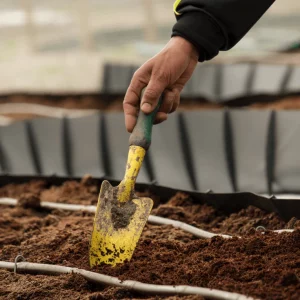Trees should save the planet !
More and more companies and organisations are getting involved in planting trees. At first glance this is a good idea, but at second glance the matter is more complicated.
Planting trees only makes sense if it is not about mass, as is unfortunately the case with many tree planting campaigns, but about the quality of the reforestation. The following criteria should be taken into account:
- whether the tree will still be standing in a few years.
- whether it is defended against forest fires.
- how much carbon it binds and how quickly this happens.
- what value it has in the local ecosystem.
- whether local jobs will be created as part of the planting action.
- whether sustainable, alternative sources of local income are created in the long term (if illegal logging is an issue).
It is therefore important for every tree planting campaign that the above criteria are met and that everyone, every company, tries to ensure that the tree planting organisation involved works according to the highest qualitative standards. Planting trees in Europe makes little sense.
Growmytree.com the organisation that plants TREE GUM trees works to the highest possible standards and ensures that required quality criteria are met.
U

Coming to the tree: on the sense & nonsense of tree planting campaigns
Many people have recently started planting trees. Not only private individuals like to get involved in the fight against climate change by planting trees, but also companies have discovered this form of commitment for themselves. Millions are raised in this way, entire television galas are dedicated to the topic, but it is problematic.
Why? Because a tree is much more than just a seedling. Because we are against cheap tree planting campaigns on a piecework basis and because quality rather than quantity should also be the decisive factor in reforestation. In view of the urgency of the situation, we would like to focus not only on the reforestation of destroyed forests but also on the protection of the last remaining intact rainforests. Dr Sophia Benz, Managing Director of BOS Switzerland, explains how we combine renaturation, reforestation, forest and species protection and why this makes sense:
Planting trees en masse. That's a great idea to counteract climate change, isn't it?
No. Mass should not be the decisive criterion - but it often is. So-called "tree planting challenges" serve gamification and ultimately entertainment. In a sense, they are a PR tool that merely facilitates communication on what is actually a complex topic. However, as is often the case in life, reforestation should be primarily about quality. We need to ask ourselves where and how afforestation can best take place and be most efficient, because: The amount of money available is limited and the time for afforestation is running out.
So it's not "the more trees planted, the better"? The number of trees would be a wonderful indicator for successful climate protection!
No. What counts is...
... whether the tree will still be standing in a few years.
... whether it is defended against forest fires.
... how much carbon it binds and how quickly this happens.
... what value it has in the local ecosystem.
... whether local jobs will be created as part of the planting campaign.
... whether sustainable, alternative sources of local income are created in the long term (if illegal logging is an issue).
Many companies that want to get involved in this area also evaluate tree planting projects in terms of whether they have a Swiss connection and for this reason prefer to plant here locally...
Yes, and that is exactly what I would advise against. Of course it's nice to have your own little pear orchard on Lake Constance. You can delight your customers with your own pear juice and awaken feelings of home. Of course, that creates loyalty. But neither at Lake Constance nor elsewhere in Switzerland do we have a shortage of trees. Reforestation in tropical areas makes much more sense, because everything grows faster and more luxuriantly there. In this way, more carbon is sequestered more quickly. Reforestation is most efficient in tropical peat bog areas. Peat swamp rainforests sequester up to forty times more carbon than conventional rainforests! Forest protection also makes a lot of sense there, because if these forests burn, they release many times more CO2 than other forests. Moreover, the biodiversity of these forests is unparalleled. The forest protects a large number of endemic animals, i.e. animals that only live there and are threatened with extinction.
Why do we distinguish between a seedling and a tree? After all, a seedling is just a small tree ...
A tree is much more than just the seedling! Therefore, afforestation must involve much more than just planting seedlings. In particular, it usually needs a sensible preparation of the soil so that the seedling will also thrive. In the peat bog areas that BOS is reforesting, former drainage canals have to be closed to rewet the soils. This part of the project is actually the expensive one. Seeds should be collected locally and grown in own nurseries by local forces and then planted. Broken seedlings have to be removed and replaced. For this reason, the price of a tree (7.65 Swiss francs) at BOS Switzerland includes the seedling plus 5 years of tree care. Fire protection must also be practised and environmental education is useful to combat illegal logging. A cheap tree or sapling for one franc can never and never do that.
What advice would you give to companies and donors who want to plant trees?
- Plant trees, not saplings!
- Reforests in tropical areas, if possible in peat swamp forests.
- The quality of the planting action and not the quantity (the number of trees) is crucial. Pay attention to which varieties are planted. Theoretically, you can also offset CO2 with a palm oil plantation, which of course makes little sense.
- Pay attention to the local land ownership or management conditions, otherwise the seedling might not stand tomorrow.
- Work with organisations that have a local presence and provide you with a reliable and critical contact in Switzerland.
- Whenever possible, prefer to work directly with the implementing organisation or, if you are interested in donating, contact institutions that plan and implement projects themselves. Donation platforms with various tree planting campaigns always involve third parties who are co-financed by the incoming donations.
- Last but not least: afforestation takes time, and afforested areas may never be suitable habitats for endangered species. Time is pressing, so it is crucial to preserve existing and intact forests! Forest conservation as a broad concept makes much more sense than just afforestation. I therefore advocate a combination of renaturation and afforestation on the one hand and forest protection on the other. Moreover, the latter can only succeed if this protection is accompanied by sustainable development, education and awareness-raising.

